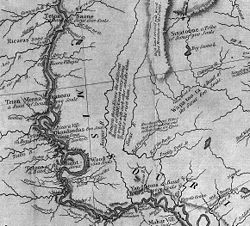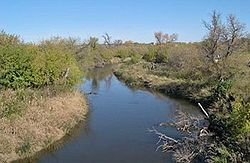
James River (Dakotas)
Encyclopedia

Missouri River
The Missouri River flows through the central United States, and is a tributary of the Mississippi River. It is the longest river in North America and drains the third largest area, though only the thirteenth largest by discharge. The Missouri's watershed encompasses most of the American Great...
, approximately 710 mi (1,143 km) long, draning an area of 20653 mi2 in the U.S. state
U.S. state
A U.S. state is any one of the 50 federated states of the United States of America that share sovereignty with the federal government. Because of this shared sovereignty, an American is a citizen both of the federal entity and of his or her state of domicile. Four states use the official title of...
s of North Dakota
North Dakota
North Dakota is a state located in the Midwestern region of the United States of America, along the Canadian border. The state is bordered by Canada to the north, Minnesota to the east, South Dakota to the south and Montana to the west. North Dakota is the 19th-largest state by area in the U.S....
and South Dakota
South Dakota
South Dakota is a state located in the Midwestern region of the United States. It is named after the Lakota and Dakota Sioux American Indian tribes. Once a part of Dakota Territory, South Dakota became a state on November 2, 1889. The state has an area of and an estimated population of just over...
. The river provides the main drainage of the flat lowland area of the Dakotas between the two plateau
Plateau
In geology and earth science, a plateau , also called a high plain or tableland, is an area of highland, usually consisting of relatively flat terrain. A highly eroded plateau is called a dissected plateau...
regions known as the Coteau du Missouri
Coteau du Missouri
The Coteau du Missouri, or Missouri Plateau, is a large plateau that stretches along the eastern side of the valley of the Missouri River in central North Dakota and north-central South Dakota in the United States...
and the Coteau des Prairies
Coteau des Prairies
The Coteau des Prairies is a plateau approximately 200 miles in length and 100 miles in width , rising from the prairie flatlands in eastern South Dakota, southwestern Minnesota, and northwestern Iowa in the United States...
. This narrow area was formed by the lobe of a glacier
Glacier
A glacier is a large persistent body of ice that forms where the accumulation of snow exceeds its ablation over many years, often centuries. At least 0.1 km² in area and 50 m thick, but often much larger, a glacier slowly deforms and flows due to stresses induced by its weight...
during the last ice age
Ice age
An ice age or, more precisely, glacial age, is a generic geological period of long-term reduction in the temperature of the Earth's surface and atmosphere, resulting in the presence or expansion of continental ice sheets, polar ice sheets and alpine glaciers...
, and as a consequence the watershed of the river is slender and it has few major tributaries for a river of its length.
The river rises in Wells County, North Dakota
Wells County, North Dakota
-Demographics:As of the census of 2000, there were 5,102 people, 2,215 households, and 1,453 families residing in the county. The population density was 4 people per square mile . There were 2,643 housing units at an average density of 2 per square mile...
, approximately 10 mi (16 km) northwest of Fessenden
Fessenden, North Dakota
As of the census of 2000, there were 625 people, 279 households, and 171 families residing in the city. The population density was 1,378.4 people per square mile . There were 306 housing units at an average density of 674.9 per square mile . The racial makeup of the city was 99.20% White, 0.32%...
. It flows briefly east towards New Rockford
New Rockford, North Dakota
As of the census of 2000, there were 1,463 people, 651 households, and 378 families residing in the city. The population density was 970.7 people per square mile . There were 778 housing units at an average density of 516.2 per square mile...
, then generally SSE through eastern North Dakota, past Jamestown
Jamestown, North Dakota
As of the census of 2000, there were 15,527 people, 6,505 households, and 3,798 families residing in the city. The population density was 1,246.7 per square mile . There were 6,970 housing units at an average density of 559.6 per square mile...
, where it is first impounded by a large reservoir (the Jamestown Dam
Jamestown Dam
The Jamestown Dam is a rolled-earth dam spanning the James River in Stutsman County in the U.S. state of North Dakota, serving the primary purpose of flood control. It is located north of the city of Jamestown, North Dakota. Built from April 1952 to September 1953, the dam measures long at the...
), and then joined by the Pipestem River
Pipestem River
The Pipestem River is a short river—usually called "Pipestem Creek" by the locals—in east-central North Dakota.It flows briefly from Wells County into a reservoir formed by Pipestem Dam north-northwest of Jamestown, North Dakota, and thence into the James River, the confluence being on the...
. It enters northeastern South Dakota in Brown County, where it is impounded to form two reservoirs northeast of Aberdeen
Aberdeen, South Dakota
Aberdeen is a city in and the county seat of Brown County, South Dakota, United States, about 125 mi northeast of Pierre. Settled in 1880, it was incorporated in 1882. The city population was 26,091 at the 2010 census. The American News is the local newspaper...
.

Columbia, South Dakota
Columbia is a city in Brown County, South Dakota, United States. The population was 136 at the 2010 census.-Geography:Columbia is located at ....
, it is joined by the Elm River. Flowing southward across eastern South Dakota, it passes Huron
Huron, South Dakota
Huron is a city in Beadle County, South Dakota, United States. The population was 12,592 at the 2010 census. It is the county seat of Beadle County. Huron was the home of now-defunct Huron University since 1897. Huron is also the home of the South Dakota State Fair...
and Mitchell
Mitchell, South Dakota
-Demographics:As of the census of 2000, there were 14,558 people, 6,121 households, and 3,599 families residing in the city. The population density was 1,475.7 people per square mile . There were 6,555 housing units at an average density of 664.4 per square mile...
, where it is joined by the Firesteel Creek. South of Mitchell, it flows southeast and joins the Missouri just east of Yankton
Yankton, South Dakota
Yankton is a city in, and the county seat of, Yankton County, South Dakota, United States. The population was 14,454 at the 2010 census. Yankton was the original capital of Dakota Territory. It is named for the Yankton tribe of Nakota Native Americans...
.
Originally called "E-ta-zi-po-ka-se Wakpa," literally "unnavigable river" by the Dakota tribes, the river was named Rivière aux Jacques (literally, "James River" in English) by French explorers. By the time Dakota Territory
Dakota Territory
The Territory of Dakota was an organized incorporated territory of the United States that existed from March 2, 1861, until November 2, 1889, when the final extent of the reduced territory was split and admitted to the Union as the states of North and South Dakota.The Dakota Territory consisted of...
was incorporated, it was being called the James River. This name was provided by Thomas L. Rosser
Thomas L. Rosser
Thomas Lafayette Rosser was a Confederate general during the American Civil War, and later an officer in the Spanish American War and railroad construction engineer. A favorite of J.E.B...
, a former Confederate general who helped to build the Northern Pacific Railroad across North Dakota
North Dakota
North Dakota is a state located in the Midwestern region of the United States of America, along the Canadian border. The state is bordered by Canada to the north, Minnesota to the east, South Dakota to the south and Montana to the west. North Dakota is the 19th-largest state by area in the U.S....
. A Virginian, he named the river and the settlement of Jamestown, North Dakota
Jamestown, North Dakota
As of the census of 2000, there were 15,527 people, 6,505 households, and 3,798 families residing in the city. The population density was 1,246.7 per square mile . There were 6,970 housing units at an average density of 559.6 per square mile...
, after the English colony of Jamestown, Virginia
Jamestown, Virginia
Jamestown was a settlement in the Colony of Virginia. Established by the Virginia Company of London as "James Fort" on May 14, 1607 , it was the first permanent English settlement in what is now the United States, following several earlier failed attempts, including the Lost Colony of Roanoke...
. (The coincidence of the old French name "Jacques" directly translating as "James" in English is noted.) However, the Dakota Territory Organic Act
Organic Act
An Organic Act, in United States law, is an Act of the United States Congress that establishes a territory of the United States or an agency to manage certain federal lands. The first such act was the Northwest Ordinance, enacted by the Congress of the Confederation in 1787 in order to create the...
of 1861 renamed it the Dakota River. The new name failed to attain popular usage and the river retains its pre-1861 name.

